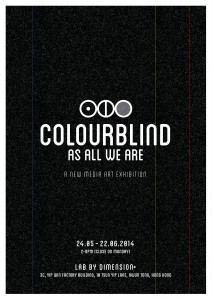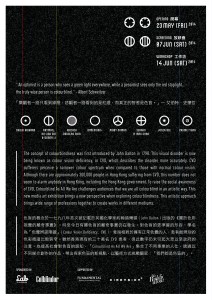Richard was so friendly to write his answers in detail on The Color Blindness Project Questionnaire. Thanks! I thought putting this together into an article by itself makes it more public to other interested readers. So the here are his answers:
When did you first discover you were colourblind?
My parents suspected when I was about 4. I could arrange the vivid primary coloured blocks of my toys, but anything less than vivid, crayons, clothes food, I was misidentifying what colour they were.
A trip to The Natural History Museum in London with an exhibit on the eye, and on colour vision, confirmed this when I did all the classic misreading of the Ishihara test. By the time the formal colour test rolled around at school, it was pretty much a foregone conclusion.
How did you discover you were colourblind?
Well aside from being told the story above, it was for me, being simply unable to colour things in correctly or recognise colours.
- For years, my anti-smoking posters at school had cigarette butts in brightest green.
- My Union Jack was easy to identify: It was purple and orange.
- All my drawings throughout my youth were in my own special palette.
And it continues. There was a lot of hoo-ha in the news recently about our beloved British brand Cadbury being taken over by US Multinational Kraft, “the famous purple wrapper” the newsman announced. — Purple? I’m 29. I had no idea. I thought it was blue.
What are the issues/problems you have faced being colourblind?
Well disability, let’s just define that, depends on how society is organised. What I have is an altered sensitivity to the spectrum, this only matters when things are categorised by colour, then I am adrift in a canoe without a paddle.
An example, only a trivial one, I was attending a job interview and the waiting area was a calendar which denoted all the religious festivals of about 10 different faiths. The key was colour code and the days and months were festooned with little coloured dots, which were meant to be wonderfully informative about which religious festivals fell on which days. I couldn’t tell them apart. Moreover if someone had been there and said what about that one, what colour is that? I’d have been guessing. I’ve gotten pretty good at that: guessing. And false positives are self correcting.
I see what I think are the colours but I have very little ability to tell them apart. I’m a diagnosed protanope so very strong red blind, and this cuts a swathe through my sensitivity to reds, greens, browns, yellow, oranges, and the pseudoisochromatic colours with which I can (and do) confuse them.
Thus, red can appear black or dark grey, but not always. Blood for instance to me looks brown, very dark. I do see a red – coca cola cans for example, but I’d bet what I think of as red probably isn’t and is very much dependent on the context. Take my coca-cola red and put it on a snooker table and I bet I’d confuse that red with something else. That’s why grass is green. Of course grass is green. But green in other contexts is where hue, and brightness combine to confound me.
- Blue and purple, covered that one.
- Orange and certain browns.
- Yellow and green.
- Grey, certain greens and pink are completely interchangeable.
Everyone all thinks traffic lights are hard, they aren’t – not really. You learn them by sequence. What they aren’t is the right colours. The two red and amber, to me look like slightly different species of yellow. And the green at the bottom, is white – it looks like an ordinary light bulb.
Of slightly more difficulty are brake-lights. Recognising those from tail lights is hard. I’ve hit the brakes hard, once to often now to believe that I’m not just a bad driver.
How did you overcome the shortcomings?
I have very sympathetic parents. My brother is the same, so they coped with both of us down the years.
Teachers, I think don’t get it. And I don’t blame them. Colours are a second alphabet. People assume you know what they are talking about. Even when you tell them, if they remember at all, it’s rare that they alter their behaviour.
And what do you tell them?
I’m colour blind?
What you can’t see colours?
Well..no..or …yes..but..I..can’t tell them apart.
What colours’ this [ ]* then?
*[ ] insert nearest object here.
and that’s how it usually goes.
Colour vision deficiency takes longer to say, as does the explanation, and I prefer it but I don’t think it helps people understand. I’d prefer they had a solid grounding in colour-theory instead.
It’s taken some time for me to get my head round it, but I am not sensitive (cannot see) certain hues. The hues I can see are modulated by brightness. A sufficiently bright green is as yellow to me. Purple’s an interesting one, because what is reflected is blue and red light, I can detect the blue, I am insensitive to the red, all purples are species of lighter or darker blues.
My solutions are if it’s important that it’s coloured I label it. It is simply no good relying on me to see a colour and recognise it. I need that second level of information like a name written down. Second, I ask people. I’m pretty up front about saying I’m colour blind – I can’t see that. What colour is it? That usually works, with the above caveat that no-one has any idea what I’m actually talking about.
In my own life it was pointed out to me, that I shop for clothes by texture, I’ll go around scrunch up shirt sleeves and jumpers to see how they feel, what they look like is secondary. My wardrobe also reflects a certain bias. Lots of blues (which I can see) Lots of dark colours, greys, a few greens (definitely green not pink) and black.
What else can be included/excluded in the guide book for parents other than the ones described above to make it more comprehensive?
Oooh. I wouldn’t want to frighten them. An introduction to Ishihara—as that is what they will likely encounter and have to sit with their child through, what it means and how it diagnoses.
I think I would personally want an easy to understand overview of what colour is (wavelengths of light), the idea of a colour gamut, a colour space, (RGB etc). And then how colourblindness changes that. How the Ishihara dots are painted in the pseudoisochromatic colours that exist in those spaces for people like me who lack sensitivity to one of the spectral colours of light.
What it means: not that my world is uncoloured. I swear to you it isn’t. I just have no idea what those colours are called. It’s rather like having a virtuoso chef who can create all the world’s dishes out of only three ingredients. A little of this, a little of that, a pinch of the other and *foompf* Egg salad nicoise. And then taking away one his ingredients. Yes he can still make all those different foods in all the variety, but without that extra thing, everything he makes is just the little bit more bland and samey. You can’t really tell them apart anymore. That would be flavour blindness. I’m colourblind in the same way.
Thank you very much Richard for this great insights.
PS: Richard updated his answers and polished them even more. You can find his latest answers on the color blindness survey at Further Adventures in the Land of the Colourblind














